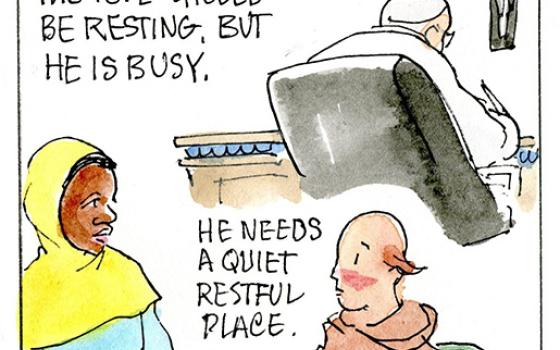No power grid is pitched steeper than that of the Catholic Church; the pope is supremely in charge. A pope may broadly consult with others or may delegate tough chores, but he finally responsible for policies and practices under his papacy.
Pope Francis' role in the current conflicts between Rome and American sisters forces the question of how exactly he is exercising his leadership. Does he sincerely minister with compassion on a personal level while allowing top cardinals to enforce conformity with church rules?
Pope Francis preaches against harshness and judgment, yet his doctrinal chief, whose influence is second only to the pope, sternly rebukes the leadership of American nuns and degrades an honor given to a top Catholiic theologian, a woman. The pope uttered no opposition to this slam. Months earlier he candidly approved the Vatican's investigation of nuns launched in 2009.
It's inevitable that action taken against sisters will be seen as reflecting the pope's view of all women. Though his rejection of women's ordination was followed by several promises to give women more leadership within their proper sphere, nothing has indicated any movement on that front.
There are those who think the fuss about American sisters is way out of proportion or well designed to curb what they sincerely believe are sisters' violation of church teaching. Like it or not, even though American sisters constitute a small slice of the world church, their visibility as Americans on the global stage and their role as precursors of how religious life responds to modernity gives them influence way beyond their numbers. Rightly or wrongly, they become examples of what the future holds, particularly how the church responds to the challenge of women in all regions.
Francis' passivity toward the rebuff handed American sisters this week has undermined two years of negotiation between Rome and the women and may have crushed the hopes of some who have been optimistic that dialog could resolve serious differences. He has passed on other contested actions against noted Catholics. One was when he declined to reconsider the ouster of peace activist Roy Bourgeois from the Maryknoll order for advocating women's ordination.
From evidence so far, it appears that Francis prefers to downplay papal power and leave painful decisions to his lieutenants. Or that he directs them to carry out the discipline and deliver the bad news. Either option assumes that, given the tight Vatican network and the top-down command, Francis knows what is about to happen before it happens.
A joyful, open minded pope in public; a practitioner of benign neglect in private, leaving the heavy lifting to Curial cardinals without his direct involvement? One who spreads good will regarding the poor, hope of reform in combating inequality, acceptance to outsiders while allowing the leading cardinals to keep the troops in order by the old rules? Time will tell, but Francis' past may provide a clue.
When elected pope, much news centered on his stance toward the Dirty War in Argentina. The gist of many accounts was that he, as the archbishop of Buenos Aires [I thank a reader for pointing out that Francis was the Jesuit provincial, not the archbishop, at that time], had refrained from speaking out against the oppressive regime that tortured and killed thousands of people. Francis' defenders pointed out that on his own he had acted with courage and passion to protect and rescue victims. He later acknowledged that he could have done more to protest the murderous dictator and that he had overcome his antipathy toward liberation theology.
In other words, an empathetic archbishop taking risks for others on his own while largely detaching himself from the wider threat. He became immersed in personal priesthood of tolerance and welcome to the poorest section of the city but could be an unbending superior in his Jesuit province. The fascination with the many sides continues; a clear picture remains elusive.




